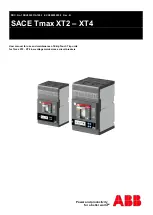
Powered by Safety
®
15
Equipment Description
01.4IB.65131
The camshaft would continue to rotate,
except that it is restrained by the close
latch shaft
. The main closing
cam, located between the mechanism
side sheets, is now in a position where the
fundamental linkage can move to the reset
position.
The close latch, when released either by the
closing coil or the manual close operator,
allows the main closing spring to pull the
crank arms upward thus rotating the main
closing cam and driving the fundamental
linkage into the closed position. This
causes the main linkage to rotate the
jackshaft such that the horizontal pushrods
are driven toward the current
carrying side of the circuit breaker.
Each horizontal pushrod assembly has
a contact loading spring
. At
the end of this spring is a spring yoke
, which connects with bell
cranks
. The spring yoke is
restrained by a lock nut on a stud which
passes through the contact loading spring
and is attached to the operating pushrod
assembly. The contact loading spring has
initial compression such that as soon as
the vacuum interrupter contacts touch,
the springs are preloaded to a value
sufficient to resist vacuum interrupter
contact separation under the highest
electromagnetic forces exerted by the rated
short circuit current. Further movement
of the operating pushrod assembly
compresses the contact loading spring
even more and produces a gap between
the face of the spring yoke and the lock
nut. This “nut gap” is used to evaluate the
erosion of the vacuum interrupter contacts.
A pair of bell cranks for each phase are
connected to a 5/8” diameter pivot pin
supported by the base pan vertical support
weldment. Each bell crank is connected to
an operating pin, which passes through a
hole in the vertical push rod which engages
an extension to the vacuum interrupter
assembly thus moving the vacuum
interrupter contact.
In the cam and fundamental
linkage positions shown in
,
the contact loading springs and the
main opening springs are both acting to
compress the three (3) main mechanism
links. The jackshaft extends from the left to
the right side of the circuit breaker frame
and is supported at the main circuit breaker
frame side sheets and by the mechanism.
The outer operating levers on the jackshaft
have connections to the circuit breaker
opening springs
.
The fundamental linkage is restrained from
movement by the secondary trip prop
acting on the primary trip prop roller.
A component of force tends to make the
primary trip prop rotate upward, but it
is restrained by the secondary trip prop
face acting on the primary trip prop roller.
The clearance between the primary trip
prop roller and the secondary trip prop
is controlled by the primary trip prop
adjusting screw. When the trip shaft is
rotated by the action of the manual trip
operator or the primary shunt trip coil, the
secondary trip prop face moves downward
and permits the primary trip prop to rotate
upward, thus permitting the main linkage
to move upward and the jackshaft to
rotate, opening the circuit breaker. The left
jackshaft levers engage a shock absorber
, which controls the rebound
of the vacuum interrupter contacts on an
opening operation. An extension of the
jackshaft projects through the left circuit
breaker side sheet and operates the MOC
actuator
.









































